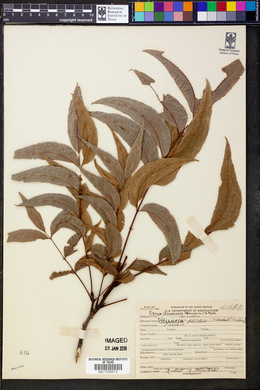Carya illinoinensis
|
|
|
|
Family: Juglandaceae
Pecan
[Carya illinoiensis K. Koch, moreCarya oliviformis , Carya pecan (Walter) Nutt., Carya tetraptera , Hicoria pecan Britton, Juglans oliviformis F. Michx.] |
Trees , to 44 m. Bark light gray or brownish, ridged with appressed scales or exfoliating with small platelike scales. Twigs tan to reddish brown, slender, hirsute, conspicuously scaly, sometimes becoming glabrous. Terminal buds yellowish brown, oblong, 6-12 mm, hirsute, scaly; bud scales valvate; axillary buds protected by bracteoles fused into hood. Leaves 4-7 dm; petiole 4-8 cm, glabrous to scurfy with short single hairs or scattered fascicles. Leaflets (7-)9-13(-17), lateral petiolules 0-7 mm, terminal petiolules 5-25 mm; blades ovate-lanceolate, often falcate, 2-16 × 1-7 cm, margins finely to coarsely serrate, without tufts of hairs, apex acuminate; surfaces abaxially hirsute or with scattered unicellular and 2-rayed fasciculate hairs, scaly with large peltate scales and small round peltate scales, adaxially without hairs or rarely hirsute with unicellular hairs along midrib, and with scattered 2-6-rayed fasciculate hairs, moderately scaly in spring. Staminate catkins essentially sessile, to 18 cm, stalks with small capitate-glandular trichomes; anthers sparsely pilose. Fruits dark brown, ovoid-ellipsoid, not compressed, 2.5-6 × 1.5-3 cm; husks rough, 3-4 mm thick, dehiscing to base or nearly so, sutures winged; nuts tan to brown and mottled with black patches, ovoid-ellipsoid, not compressed, not angled, smooth; shells thin. Seeds sweet. 2 n = 32. Flowering spring. Along stream banks, river flood plains, and on well-drained soils; 0-600(-1000) m; Ark., Ill., Ind., Iowa, Kans., Ky., La., Miss., Mo., Okla., Tenn., Tex.; Mexico. Carya illinoinensis is the state tree of Texas. Native Americans used Carya illlinoinensis medicinally as a dermatological aid and as a remedy for tuberculosis (D. E. Moerman 1986).
Bark deeply furrowed; lfls 11-17, oblong- lanceolate, the lateral conspicuously falcate, the terminal commonly on a stalk 2-4 mm; frs in spikes of 3-10, ellipsoid or cylindric, 3-5 cm, narrowly winged to the base; nut ellipsoid or cylindric, terete, 2.5-4 cm, brown, smooth, short-pointed; kernel edible, each half barely notched at the tip; 2n=32. Wet alluvial forests; sw. O. to Io. and e. Kans., s. to Ala., Tex., and N. Mex. (C. pecan) C. آrownii Sarg. is a hybrid with C. cordiformis; C. خussbaumeri Sarg., with C. laciniosa; C. جecontei Little, with C. aquatica; and C. سchneckii Sarg., with C. tomentosa. Gleason, Henry A. & Cronquist, Arthur J. 1991. Manual of vascular plants of northeastern United States and adjacent Canada. lxxv + 910 pp. ©The New York Botanical Garden. All rights reserved. Used by permission. From Flora of Indiana (1940) by Charles C. Deam Infrequent or local in the Ohio River Bottoms as far east as Bethlehem, Clark County, up the Wabash River as far north as 4 miles south of Covington, Fountain County, up White River into Greene County, and known up the Muscatatuck River into Washington County. It was formerly a common tree in Point Township of Posey County and in the southwest part of Gibson County. Its habitat is river bottoms that are usually inundated annually. ...... Indiana Coefficient of Conservatism: C = 4 Wetland Indicator Status: FACW Deam (1932): So far as the wood is concerned, the pecan is the poorest of all hickories. It has only about a half the strength and stiffness of the shagbark hickory. Although the wood is inferior, the pecan has the distinction of producing the best nut of any native tree of North America. The pecan was well known to the Indians, and some authors say the range of the species was extended by planting by the Indians. It has been a nut of commerce ever since the area of its range has been settled. It was planted by the pioneers, and recently nurserymen took up the subject of growing stock by budding and grafting from superior trees. At present there are about 100 horitcultural varieties. The horticulturist has developed forms twice the size of the native nuts, and with shells so thin as to be styled "paper-shelled." The pecan has been extensively planted for commercial purposes in the southern states, but information obtained from owners of pecan trees in Indiana indicate that the winters are too severe for profitable pecan culture in Indiana. During the winter of 1917-1918 the whole of a tract of 13 year old pecan trees on the Clark County State Forest was killed back to the ground. In Noble County about one mile south of Wolf Lake is a tree planted about 50 years ago and is now about 9 dm. in circumference; it frequently sets nuts but they never mature on account of early frosts.
|



















































































